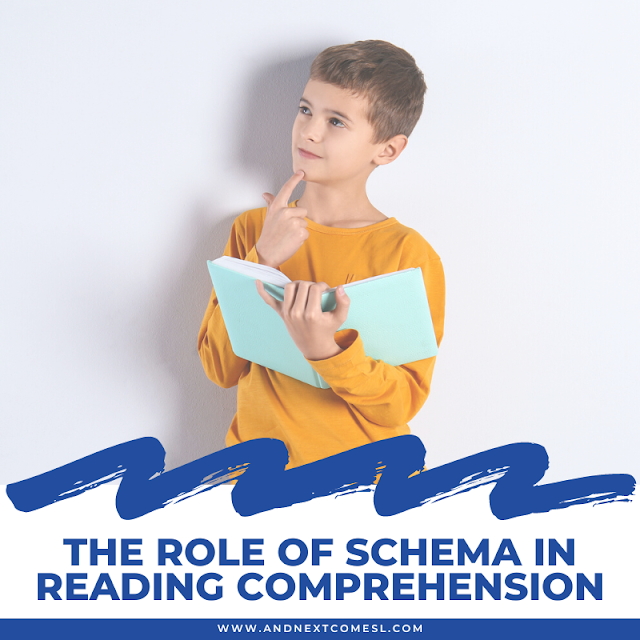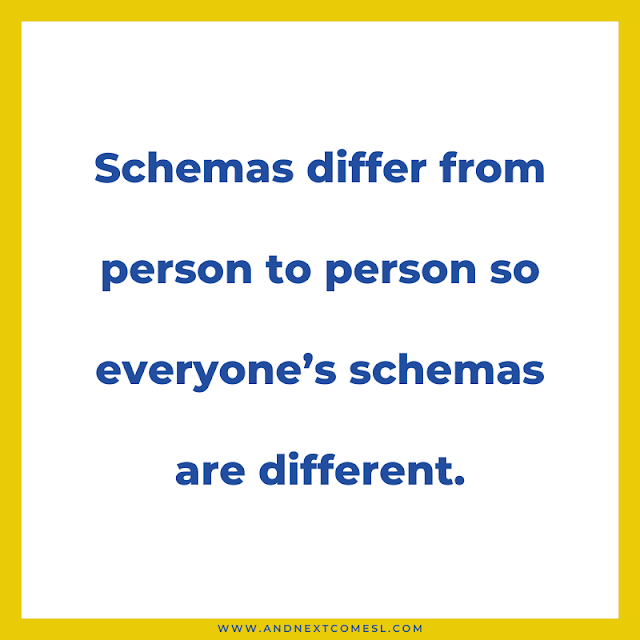The term schema came up again and again in some recent comprehension webinars and workshops that I attended and it really got me thinking about how I work with my own son on his comprehension skills.
See, when it comes to improving the comprehension of hyperlexic kids, schema plays a huge role. It also makes a big difference in helping your kids make connections while reading.
But what is schema exactly?
And what is the role of prior knowledge or background knowledge in reading comprehension?
Well, let's take a closer look at schema and reading comprehension and find out.
What is Schema in Reading Comprehension?
Schema refers to the information we have stored in our brain, made up of the background knowledge and prior experiences that we have for different topics and ideas. It refers to everything we know (or, rather, everything we think we know) about those topics.
It's important to note that schemas are dynamic, constantly changing and growing as we learn and experience new things.
They also differ from person to person, meaning your schema on one topic will be different than my schema. So it's important to remember that everyone's schemas are different.
How Does Background Knowledge or Schema Affect Reading Comprehension?
As much as my husband has tried to explain what he does for a job to me, I truly don't understand much of it because my schema is basically nil. I have no experience using the things he talks about and I don't really understand the jargon and language that accompanies it all.
But talk to me about piano teaching repertoire, neuroscience, psychology, video games, hyperlexia, or autism? You bet I'll understand what you're talking about because I already have schemas built on these topics to aid in my understanding.
Not having the right amount of background knowledge can make it difficult to understand things.
Like you might not have a clue what I'm talking about when it comes to piano teaching repertoire, right? But if you had some schema about how to teach piano, what piano method books exist, and had personal experience using some of those books yourself, then you could likely understand what the heck I was talking about.
You can see how being able to access and use your prior knowledge can build a greater depth of understanding. Using schema also allows kids to make connections while reading. And it even aids in visualizing what you read, a core component of the Visualizing and Verbalizing program (review here), because the schema is there to help you picture what it should look like.
So if you want to start improving your hyperlexic child's comprehension skills, then building and activating schema is extremely important.
So...How Do You Build Schema?
There are lots of different ways to build schema surrounding a topic, including:
- Reading books
- Watching videos or documentaries
- Looking up information on the internet
- Listening to a podcast
- Offering sensory rich experiences
- Trying something yourself
- Talking to someone who you deem to be an expert or more knowledgeable
- Discussing the topic with someone else
- Asking questions when you're unfamiliar with something
For example, if you don't know anything about sharks, you might read a nonfiction book about sharks, watch videos on YouTube about different types of sharks, read the Wikipedia entry on sharks, make a shark sensory bin, and/or go to a local aquarium to see sharks in person. All of the tidbits of information you gather from these sources will contribute to your knowledge - or schema - of sharks.
Ideas for Activating Background Knowledge & Schema for Reading Comprehension
You now recognize how important it is to build and activate schema, but how do you actually activate schema when reading? Here are some suggestions of things you can do before reading:
- Share the topic with your child and ask them what they already know about it (you can write these things down or have them just share it verbally, up to you)
- Ask them questions related to the topic or the book/text you will be reading to help awaken and ready their brain (using a graphic organizer for this step can be super helpful!)
- Do a picture walk
- Introduce vocabulary words and provide definitions
- Look at photos or watch a short YouTube video that is related to topics, situations, or experiences that will be discussed in the text
A Recap of the Role of Prior Knowledge in Reading Comprehension
Let's just recap all that we discussed above regarding schema and background knowledge.
- Schema refers to the information that we have for different topics and ideas that are stored in our brain.
- Schemas are dynamic and differ from person to person.
- Being able to access and use your schema and prior knowledge can boost comprehension by building a greater depth of understanding, helping kids make connections, and aiding in visualizing, among many other things.
- You can build schema by reading books, watching videos, doing some research, engaging in sensory rich experiences, trying something out, and more!
- You can activate schema by doing picture walks, introducing vocabulary words, asking questions, and various other activities.
This video would be helpful to show your kids (especially autistic and hyperlexic kids who find social stories helpful!) as it explains how to use schema or prior knowledge when reading. It also includes some concrete examples. Definitely check it out for more info!
I also highly recommend reading how high interest books improve comprehension for hyperlexic learners, as it digs a bit deeper into some of the research on hyperlexia and schema.
So, that's an overview of schema in reading comprehension. Hopefully, you can recognize how important building schema and background knowledge is.











